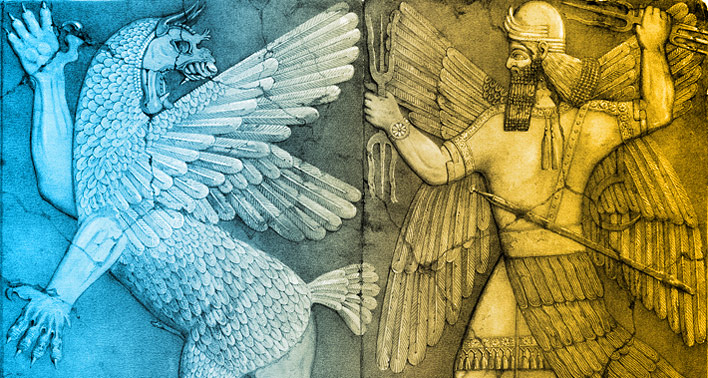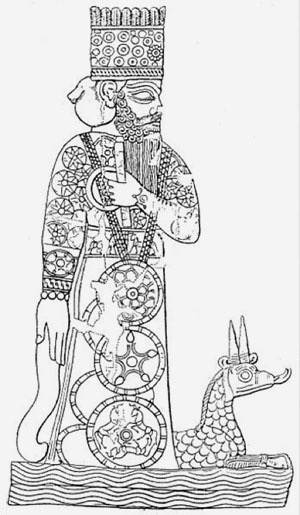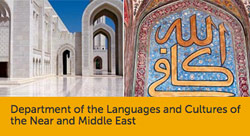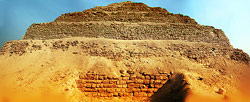
Mesopotamia:
Early Signs of Monotheism
During the reign of Hammurabi in the 18th century BCE, Babylon became the principal city of southern Mesopotamia, and the patron deity of Babylon, the god Marduk, was elevated to the level of supreme god. Marduk eventually became head of the Mesopotamian pantheon, absorbing the qualities and characteristics of over 50 deities; his ascension is one of the first indications of what would eventually become monotheism.

In The Babylonian Genesis: The Story of Creation, Assyriologist and biblical scholar Alexander Heidel described the Enuma Elish (“When above”) as created by the Babylonian priests to illustrate how the rise of Marduk came about and to sing the praises of Babylon and strengthen her claim to supremacy over all the cities of the land. Although the oldest extant copies date to 1000 BCE, it was likely written in the First Babylonian Dynasty (1894–1595 BCE) during the reign of Hammurabi when Marduk became the national god.
The Mesopotamians recited, or chanted, their epics at special times to honor the god in question. The effect was hauntingly rhythmic and believed to have great power to exorcise evil spirits, to stem the potential inundation of the city by the rise of the rivers once the snows had melted, and so on.
According to the Enuma Elish (Enûma Eliš), Marduk demanded supreme and undisputed authority among the gods as his reward for delivering them from disaster. He proved worthy and was granted “kingship over the totality of the whole universe.” The city of Babylon and Marduk’s great temple complex, the Esagila, south of the ziggurat Etemenanki, was built by the Anunnaki (a general designation for all the gods of heaven and earth) in gratitude to Marduk for their deliverance. After its completion, a joyful banquet took place at which attendees recited the fifty names previously attributed to various gods, which were now passed on to Marduk with all their attributes and abilities, making “his way pre-eminent.”
Marduk, as creator of the present world order, was honored every New Year in a sacred festival at which Babylonians believed the great pantheon of gods actually entered the city in order to honor him. As part of the festivities the Enuma Elish was read twice by the high priest as he stood before the statue of the god Marduk while the king and guests are thought to have dramatized the narration.
As previously mentioned, it is not possible to assert the dates of any of these creations since they were written and rewritten and must originally have stemmed from oral sources. Stories, such as the creation story, were revised to suit the times but earlier versions were retained. Scholars claim that all the tablets found in Ashurbanipal’s library at Nineveh or from the cities of Ashur, Kish or Uruk are copies of older ones.
From 668–627 BCE in the time of Ašhurbanipal and the Neo-Babylonian Dynasty and again in the Early Persian period of Cyrus the Great, Marduk was the chief god of Babylon. Because they opposed the oppressive measures of Nabonidus, the last Neo-Babylonian king, the priests of Marduk facilitated the peaceful occupation of Babylon by Cyrus. With Cyrus and the Persians came the teachings of Zoroaster, which claimed Ahura Mazda as the Supreme True God. These two ways of understanding the universe and our place in it – the Babylonian and Zoroastrian – would influence Judeo-Christian thought from its first recorded beginnings to the present day.
In 587 BCE Nebuchadnezzar the Babylonian king, son of King Solomon and the Queen of Sheba, violently ransacked Judah, the capital of Ancient Israel and took the young king Jehoiachin and 8,000 of his people, including royal and aristocratic families, prisoners to Babylon. The now famous Babylonian Exile left little doubt in the minds of the people of Babylonia of the supreme power of their own national god, Marduk.
In the series: Mesopotamia
Related articles:
- The Noble Ones
- Indus-Sarasvati Civilization
- Mehrgarh 7000–2000 BCE
- Harappa 3500–1900 BCE
- Mohenjo-Daro 2600–1900 BCE
- The Demise of this Great Civilization
- Who Were They and What Did They Believe?
- The Cycladic Civilization Circa 3300 to 1100 BCE
- Minoa – Europe’s First Civilization
- Minoan “Palaces” and Religious Beliefs
- Conflict and Calamity
- The Mycenaeans 1600–1100 BCE
- Archaic Greece: The Dark Age and a New Dawn
- Emerging from the Dark Age 800–500 BCE
- History According to the Storytellers
- Religious Life
- Early Civilizations China
- Three Legendary Sovereigns
- The Five Emperors
- The Shang Dynasty 1600–1045 BCE
- Neolithic Era: Cosmic and Terrestrial Maintenance
- Death and Transcendence
- Replicating the Cave Experience
- Beliefs and Customs Journey West
- Temples of Malta – A Scientific Breakthrough
- A Mega Building Boom as the Era Ends
- Pyramids: Stairway to the Gods
- The Noble Ones
- Indus-Sarasvati Civilization
- Mehrgarh 7000–2000 BCE
- Harappa 3500–1900 BCE
- Mohenjo-Daro 2600–1900 BCE
- The Demise of this Great Civilization
- Who Were They and What Did They Believe?
Further Reading
External Stories and Videos

Listen: Ancient Poetry of Babylon
SOAS University of London
Hear ancient Babylonian and Assyrian poetry and literature in the original language.

Pyramids: Stairway to the Gods
Found on at least three continents, pyramids are yet another example of how humans expressed their place in a three-tiered universe.
